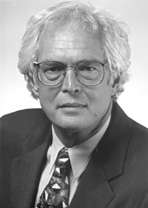Thomas M. Cover
| Thomas M. Cover | |
|---|---|
 | |
| Born |
August 7, 1938 San Bernardino, California, U.S. |
| Died |
March 26, 2012 (aged 73) Palo Alto, California, U.S. |
| Residence | U.S. |
| Nationality | U.S. |
| Fields |
Information Theory Electrical Engineering Statistics Pattern Recognition |
| Institutions | Stanford University |
| Alma mater |
|
| Doctoral advisor | Norman Abramson |
| Doctoral students |
Mohammad Reza Aref Martin Hellman Peter E. Hart Abbas El Gamal |
| Known for |
Information theory Nearest Neighbors Algorithm |
| Notable awards |
IEEE Fellow (1974) IMS Fellow (1981) Claude E. Shannon Award (1990) AAAS Fellow (1991) Member of the National Academy of Engineering (1995) Richard W. Hamming Medal (1997) |
|
Website www-isl | |
Thomas M. Cover [ˈkoʊvər] (August 7, 1938 – March 26, 2012) was an information theorist and professor jointly in the Departments of Electrical Engineering and Statistics at Stanford University. He devoted almost his entire career to developing the relationship between information theory and statistics.
Early life and education
He received his B.S. in Physics from MIT in 1960 and Ph.D. in electrical engineering from Stanford University in 1964.
Career
Cover was past President of the IEEE Information Theory Society and was a Fellow of the Institute of Mathematical Statistics and of the Institute of Electrical and Electronics Engineers. He received the Outstanding Paper Award in Information Theory for his 1972 paper "Broadcast Channels"; he was selected in 1990 as the Shannon Lecturer, regarded as the highest honor in information theory; in 1997 he received the IEEE Richard W. Hamming Medal;[1] and in 2003 he was elected to the American Academy of Arts and Sciences.
During his 48-year career as a professor of Electrical Engineering and Statistics at Stanford University, he graduated 64 PhD students, authored over 120 journal papers in learning, information theory, statistical complexity, and portfolio theory; and he coauthored the book Elements of Information Theory, which has become the most widely used textbook as an introduction to the topic since the publication of its first edition in 1991.[2] He was also coeditor of the book Open Problems in Communication and Computation.
Selected works
- Cover, T. M.; Thomas, J. A. (2006). "Chapter 12, Maximum Entropy". Elements of Information Theory (PDF) (2 ed.). Wiley. ISBN 0471241954.
- Cover, T. and Thomas, J. (1991). Elements of Information Theory. New York: Wiley. ISBN 0-471-06259-6
- Van Campenhout, Jan. and Cover, T. (1981). Maximum entropy and conditional probability. Information Theory, IEEE Transactions on
- Cover, T. (1974). The Best Two Independent Measurements Are Not the Two Best. Systems, Man and Cybernetics, IEEE Transactions on
- Cover, T. and Hart, P. (1967). Nearest neighbor pattern classification. Information Theory, IEEE Transactions on.
- Cover, T. (1965). Geometrical and Statistical Properties of Systems of Linear Inequalities with Applications in Pattern Recognition. Electronic Computers, IEEE Transactions on
See also
References
- ↑ "IEEE Richard W. Hamming Medal Recipients" (PDF). IEEE. Retrieved May 29, 2011.
- ↑ "Thomas M. Cover In Memoriam 1938-2012". Stanford University. Retrieved April 2, 2012.
